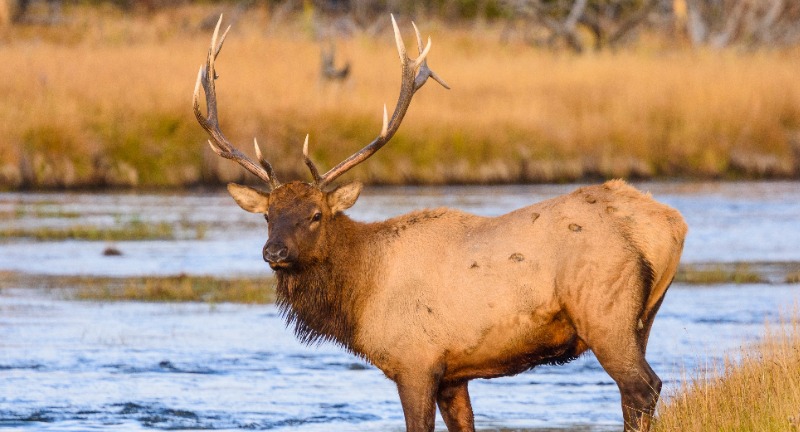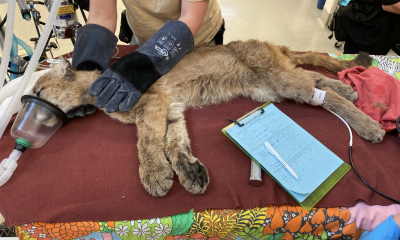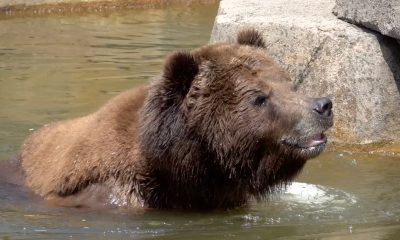NEWS
20 States Where Elk Still Thrive In The Wild
Published
4 months agoon

Shutterstock
Elk are one of North America’s most captivating wildlife species, drawing nature enthusiasts to witness their grandeur in the wild. Found in varying habitats from dense forests to sprawling grasslands, these magnificent creatures have made their mark across several U.S. states. But where can you see them in their natural glory?
Certain states offer the perfect blend of terrain and conservation efforts that keep elk populations thriving. This article unveils the top states where these regal animals roam freely, inviting you to explore their world firsthand.
Colorado

Shutterstock
Colorado boasts one of the largest elk populations in North America, with an estimated 280,000 individuals. The Rocky Mountain National Park and surrounding wilderness offer prime viewing opportunities. Elk herds here are a cornerstone of the state’s ecotourism, drawing thousands of visitors during the rutting season each fall. Conservation programs have ensured the sustainability of elk populations amid expanding urban areas.
Montana

Shutterstock
Montana’s wide-open spaces and rugged terrain make it a paradise for elk. The state is home to around 160,000 elk, spread across areas like the Bitterroot Valley and Glacier National Park. Hunting regulations and land management practices balance recreational use with conservation. Montana’s elk thrive in diverse habitats, from forests to grasslands.
Wyoming

Shutterstock
Wyoming’s Yellowstone National Park is iconic for its elk herds, with roughly 100,000 animals statewide. These elk play a vital ecological role, influencing vegetation and feeding predators like wolves and bears. Tourists flock to the park for a chance to hear the haunting bugle calls of bull elk during the fall. Conservation efforts have successfully navigated challenges such as habitat encroachment.
Idaho

Shutterstock
Idaho’s rugged wilderness supports a thriving elk population, particularly in the Clearwater Basin and Salmon River region. With over 120,000 elk, the state is a haven for both hunters and wildlife enthusiasts. Elk here are known for their adaptability, thriving in forests, meadows, and even agricultural areas. Collaborative conservation efforts have reduced conflicts between elk and local farmers.
Oregon

Shutterstock
Oregon is home to both Roosevelt elk, found in coastal areas, and Rocky Mountain elk in the eastern regions. The state boasts about 125,000 elk, making it a hotspot for wildlife observation. Elk play a vital role in Oregon’s ecosystems, particularly in forest regeneration and soil health. Conservation programs focus on habitat connectivity and reducing human-wildlife conflicts.
Washington

Shutterstock
Washington state hosts a significant elk population, primarily Roosevelt elk in the coastal rainforests and Rocky Mountain elk in the Cascades. The Olympic National Park is a notable location for observing these magnificent creatures. Elk populations here are carefully managed to balance ecological needs and recreational activities. Their presence underscores the importance of preserving Washington’s wild landscapes.
Utah

Shutterstock
Utah is known for its large elk herds, particularly in areas like the Uinta Mountains and Fishlake National Forest. With over 80,000 elk, the state is a leader in proactive wildlife management. The annual elk migration in Utah attracts researchers and wildlife watchers alike. Conservation programs focus on habitat restoration and water availability in arid regions.
Arizona

Shutterstock
Arizona’s elk, primarily found in the northern parts of the state, are a conservation success story. Transplanted from Yellowstone in the early 20th century, their population has grown to about 35,000. Areas like the Mogollon Rim and Coconino National Forest offer ideal elk habitats. Conservationists have worked to address challenges such as water scarcity and habitat fragmentation.
New Mexico

Shutterstock
New Mexico is home to thriving elk populations, especially in the Gila Wilderness and Carson National Forest. The state supports about 70,000 elk, attracting hunters and wildlife watchers. These elk benefit from diverse habitats, ranging from high-altitude forests to desert grasslands. Conservation efforts focus on protecting migration corridors and mitigating climate change impacts.
California

Shutterstock
California’s Roosevelt elk are most prominent in the northern coastal areas, including Redwood National Park. Smaller populations of tule elk, a subspecies unique to California, inhabit the Central Valley and coastal ranges. These elk contribute to biodiversity and attract nature enthusiasts to the Golden State. Conservation measures include habitat restoration and protections for tule elk herds.
Nevada

Shutterstock
Elk in Nevada are found in mountainous regions like the Ruby Mountains and Jarbidge Wilderness. With a population of about 17,000, these elk are a testament to successful reintroduction programs. Their presence has boosted local ecotourism and hunting industries. Conservation challenges include managing water resources in the state’s arid climate.
North Dakota

Shutterstock
North Dakota’s elk are primarily found in the Badlands region, thriving in rugged terrain and grasslands. While their population is smaller, around 5,000, they play a key ecological role in the area. Elk sightings are a highlight for visitors to Theodore Roosevelt National Park. Wildlife agencies work to balance elk conservation with agricultural interests.
South Dakota

Shutterstock
South Dakota’s elk population is concentrated in the Black Hills, with about 6,000 animals. These elk inhabit diverse landscapes, from forests to grasslands. Conservation efforts include monitoring herds to maintain population balance and ecological health. The state’s elk are a draw for tourists and hunters alike.
Michigan

Shutterstock
Michigan’s elk population is centered in the northern Lower Peninsula, with around 1,000 individuals. This small but thriving herd is a result of reintroduction efforts in the early 20th century. Elk have become a symbol of Michigan’s natural heritage, celebrated through festivals and tours. Habitat management and public education ensure their continued survival.
Wisconsin

Shutterstock
Wisconsin is home to a growing elk population, primarily in the Chequamegon-Nicolet National Forest. Reintroduction programs have bolstered the population to over 400 individuals. Elk here contribute to forest ecology by shaping plant communities and promoting biodiversity. Community involvement has been key to their conservation success.
Minnesota

Shutterstock
Elk in Minnesota are mainly found in the northwest, near the cities of Grygla and Lancaster. With a population of about 150, these elk represent a small but vital part of the state’s wildlife. Conservation efforts focus on habitat connectivity and minimizing conflicts with agriculture. Minnesota’s elk serve as a reminder of the region’s wild past.
Kentucky

Shutterstock
Kentucky is home to one of the largest elk herds east of the Mississippi, with over 13,000. Reintroduction programs have transformed reclaimed coal mines into thriving elk habitats. These elk are a major draw for eco-tourists and hunters, boosting the local economy. Conservation efforts emphasize habitat enhancement and sustainable population management.
Tennessee

Shutterstock
Tennessee’s elk population resides in the Cumberland Plateau, with reintroduction efforts beginning in the early 2000s. About 400 elk now roam the state, delighting visitors to the North Cumberland Wildlife Management Area. Conservation programs aim to expand suitable habitats and improve public awareness. Elk have become an iconic symbol of Tennessee’s commitment to wildlife restoration.
Pennsylvania

Shutterstock
Pennsylvania boasts a robust elk population, primarily in the north-central region near Elk County. Over 1,400 elk roam the state’s forests and meadows, thanks to successful reintroduction efforts. The Elk Country Visitor Center offers educational opportunities and guided tours. Pennsylvania’s elk have become a beloved feature of its wild landscapes.
Virginia

Shutterstock
Virginia’s elk herd, reintroduced in the southwestern part of the state, now numbers around 250. They inhabit reclaimed mining lands, showcasing the success of habitat restoration projects. Elk conservation here is a collaborative effort involving state agencies, local communities, and private organizations. Virginia’s elk are a symbol of hope for wildlife resurgence in the Appalachians.
Conclusion

Shutterstock
Elk are more than just symbols of wilderness—they are living testaments to the success of conservation and the richness of America’s natural landscapes. Exploring the states where they roam offers not only a chance to witness their beauty but also to connect with the ecosystems they help sustain. Whether you’re an avid wildlife enthusiast or a casual traveler, the presence of elk in these regions serves as a reminder of the importance of preserving our wild spaces. So pack your gear, head out to these elk-rich territories, and experience the awe of nature at its finest.
More Amazing Animals+
-


25 Benefits of Having a Basset Hound in Your Family
-


23 Animals That Thrive in Desert Climates
-


25 Reasons Why Chihuahuas Are Big Dogs in Small Packages
-


25 Things That Make Newfoundland Dogs Gentle Family Guardians
-


Roaming Mountain Lion Rescued From a Classroom in California
-


Boris the bear beating the heat at the Milwaukee County…
-


25 Reasons Why Yorkshire Terriers Are Wonderful Companions
-


22 Dangerous Animals to Watch Out for in Arizona
-


Triple otter on the rocks
-


Mama bird feeding her babies in their traffic light nest…
-


25 Traits That Set Belgian Malinois Apart as Incredible Working…
-


25 Surprising Facts About Cocker Spaniels
